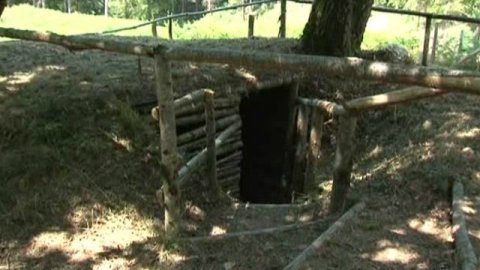The Resistance in the Haute-Vienne department

In the Haute-Vienne department, Lieutenant Colonel Guingouin is an emblematic figure of the Resistance.
Key dates:
- August 1940: Georges Guingouin's call to join the struggle, first contacts in Limoges for an organised resistance movement.
- September 1941: Georges Guingouin's first armed operation.
- Late 1941: the Combat, Franc Tireur and Libération Sud movements are organised on the departmental level.
- 13 December 1942: destruction of the supply bailer at Eymoutiers
- May 1943: sabotage of the Wattelez factory at Le Palais sur Vienne.
The south and east of the department are dominated by Mounts Châlus (546 m), Ambazac (701 m) and Gargan (731 m): inviolable strongholds for the maquis. Despite the differences between the networks (AS and FTP), Georges Guingouin managed to set up a large Maquis between Châteauneuf-la-Forêt and Chamberet. The land there is perfect for parachuting and setting up camps in the area.
In the spring of 1943, there were ever-growing numbers of young people who refused the STO (Compulsory Work Service) and joined the maquis at Eymoutiers, Saint-Léonard, Châteauneuf-la-Forêt, etc. These reinforcements were proof of the power of the maquis; they no longer carried out isolated actions, but rather outright military operations. On 10 July, the Châteauneuf FTP group went to Peyrat-le-Château to sabotage a locomotive; then, on the 12th, in Bussy-Varache, blew up the canal that supplied the hydroelectric plant in Eymoutiers and, in La Veytisous, cut the underground telephone cable that put the naval base in Bordeaux in constant contact with the Kriegsmarine's staff headquarters in Berlin.
On the 14th, the departmental tram line was cut off, isolating the cantons of Eymoutiers and Châteauneuf from the rest of the department. This time, the German army itself was affected by the destruction of its transmission and transport components. A major campaign of opposition to threshing was launched starting in August of 1943. At the start of 1944, each FTP detachment sent its best elements to the Château de La Ribeyrie (in Saint-Gilles-la-Forêt) where they were given intensive training with a view to carrying out larger operations.
The liberation of Limoges

The refurbished hideout of Georges Guingouin, first Maquisard of France. Source: Photo Christian Bélingard
At the beginning of August 1944, despite orders from his party, Georges Guingouin refused to launch an assault on the town in a concern to avoid the repeated German massacres. And yet as the departmental head of all the FFI, he had 14,000 men and 21 squadrons of Gendarmes with him. But Guingouin felt it was preferable to plan for progressively surrounding the town from his command post in Linards. This operation contributed to the paralysis that was setting in little by little. General Gleiniger, who was in charge, reacted as a soldier and, like his colleague in Brive, agreed to the idea of surrendering ”with honour” to the regular troops. The consul of Switzerland, Jean d'Albis, served as an intermediary and found an allied mission to accept their capitulation.

